

Writing And Enforcing An Effective Employee Security Policy. News Millions of websites, applications from Cisco and VMware, Google Play apps, as well as millions of Android devices are vulnerable -- and the list keeps growing.By Mathew J.
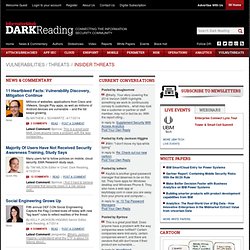
Schwartz , 4/17/2014 2 comments | Read | Post a Comment Quick Hits Many users fail to follow policies on mobile, cloud security, EMA Research study says.By Tim Wilson Editor in Chief, Dark Reading, 4/10/2014 12 comments | Read | Post a Comment Fifth annual DEF CON Social Engineering Capture the Flag Contest kicks off today with new "tag team" rules to reflect realities of the threat.By Kelly Jackson Higgins Senior Editor, Dark Reading, 4/7/2014 9 comments | Read | Post a Comment Commentary The Queens County DA recently arrested two Jamaica Hospital employees for stealing patient data, a lucrative crime occurring at hospitals across the nation. 16 comments | Read | Post a Comment. From Regulator to Business Enabler: Use Employee Communications to Re-Position Your Compliance Function.
August 15, 2012Wes Siegal Two Key Communications Challenges for Compliance Functions With a steady drumbeat of new compliance requirements resounding from Washington, Brussels, Beijing, and elsewhere, the importance of compliance communications for the industry has increased significantly in recent years.
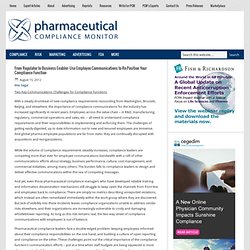
Employees across the value chain – in R&D, manufacturing, regulatory, commercial operations and sales, etc. – all need to understand compliance requirements and their responsibilities in implementing and enforcing them. The challenges of getting easily digested, up to date information out to new and tenured employees are immense. Personal E-mails and Confidentiality: What Does Your Company Policy Say? March 7, 2012 by Jerome Coenic-Taylor It seems almost inevitable that employees with Internet access via work-issued computers will use that access for personal reasons at some point during the work day.

One of the most common things that employees do is log into their personal e-mail accounts to read and send e-mails. But have you expressly informed your employees through your employee handbook or company’s website about your e-mail policy? Better yet, does your company even have an e-mail policy, and if so, does it address employees’ personal e-mail accounts? Although employees using work time to send personal e-mails is nothing new, the issue has taken on a new importance for employers and the courts because a number of employers have attempted to discover employee’s personal e-mails in litigation on the theory that e-mails made on work-issued computers and via company-provided Internet access are not private or confidential. Data Driven Reporting and Communication about IT.
In the words of one CEO, “Until they (IT management) presented what it (IT) meant to me, I ignored it (IT).
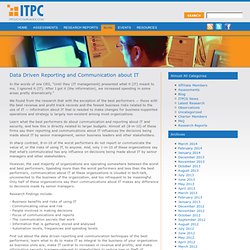
After I got it (the information), we increased spending in some areas pretty dramatically.” We found from the research that with the exception of the best performers — those with the best revenue and profit track records and the fewest business risks related to the use of IT — information about IT that is needed to make changes for business-supported operations and strategy is largely non-existent among most organizations.
Employers, beware of restrictive policies on social media - Inside Tucson Business: Media Technology. As a business owner, can you prohibit your employees from engaging in disrespectful conduct toward others or making disparaging comments about the company on the Internet or in other forms of communication?
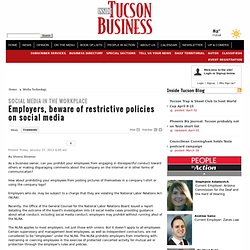
How about prohibiting your employees from posting pictures of themselves in a company t-shirt or using the company logo? Employers who do, may be subject to a charge that they are violating the National Labor Relations Act (NLRA). Recently, the Office of the General Counsel for the National Labor Relations Board issued a report detailing the outcome of the board's investigation into 14 social media cases providing guidance about what conduct, including social media conduct, employers may prohibit without running afoul of the NLRA. The NLRA applies to most employers, not just those with unions. But it doesn't apply to all employees. 1. employees would reasonably construe the language to prohibit Section 7 activity,
Internal Policy Communication. Tips for Communicating Internal Policy: All organizations have guidelines and internal policies to protect them.
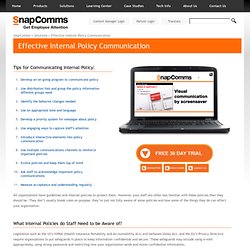
Employer did not communicate FMLA policy, can't fire worker: Appeals court. “American Standard terminated Thom for unexpected absences on June 17.
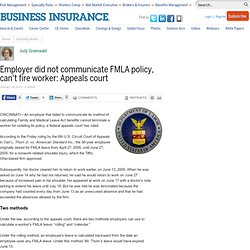
Thus, Thom needs the ‘calendar' method to apply,” the appeals court panel ruled unanimously in upholding a lower court ruling on this issue. Mr. Thom contended the company failed to inform him that it used the rolling method, and the appeals court agreed. Online. In the first article I touched on how an employer may be held vicariously liable for the conduct of its employee. In the second article I referred to real-life situations of how this has played itself out at two work spaces, and how they were concluded in court. In this article, being the last one on the subject, I will outline quite simple but valuable lessons that could assist reduce chances of triggering a claim as previously discussed. Lessons for the organisation, line management/supervisors and HR practitioners... It is one of an employer's common law duties to provide a safe working environment for employees. To partly achieve this, it is advisable to introduce sound housekeeping programmes and ensure that staff uphold the organisational housekeeping standards.
It is good practice to make sure that work space systems and rules allow reasonable employee discretion in decision making. Who is responsible for enforcing password etiquette in your business? August 17, 2011 Malware hits the Mac but is it worth worrying about?
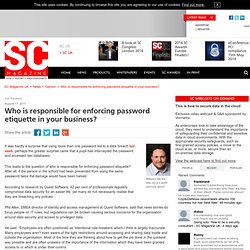
It was hardly a surprise that using more than one password led to a data breach last week, perhaps the greater surprise came that a pupil had intercepted the password and accessed two databases.